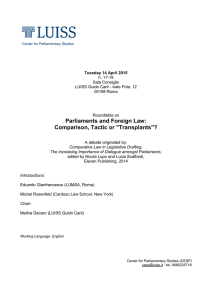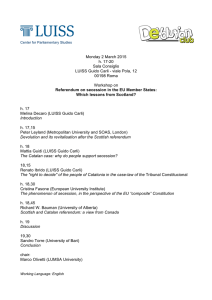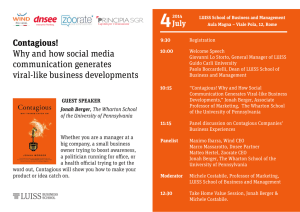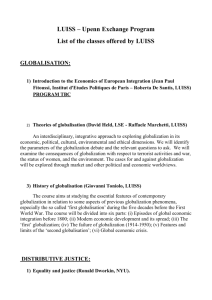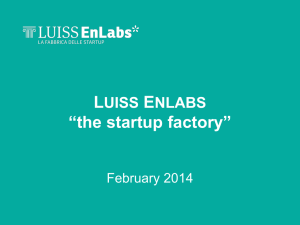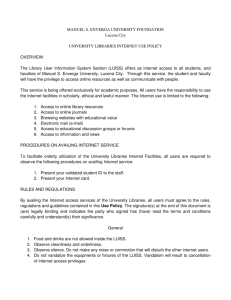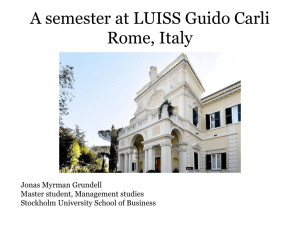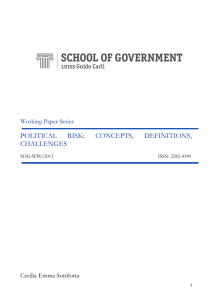LUISS - Fall 2015 - BI Norwegian Business School
advertisement
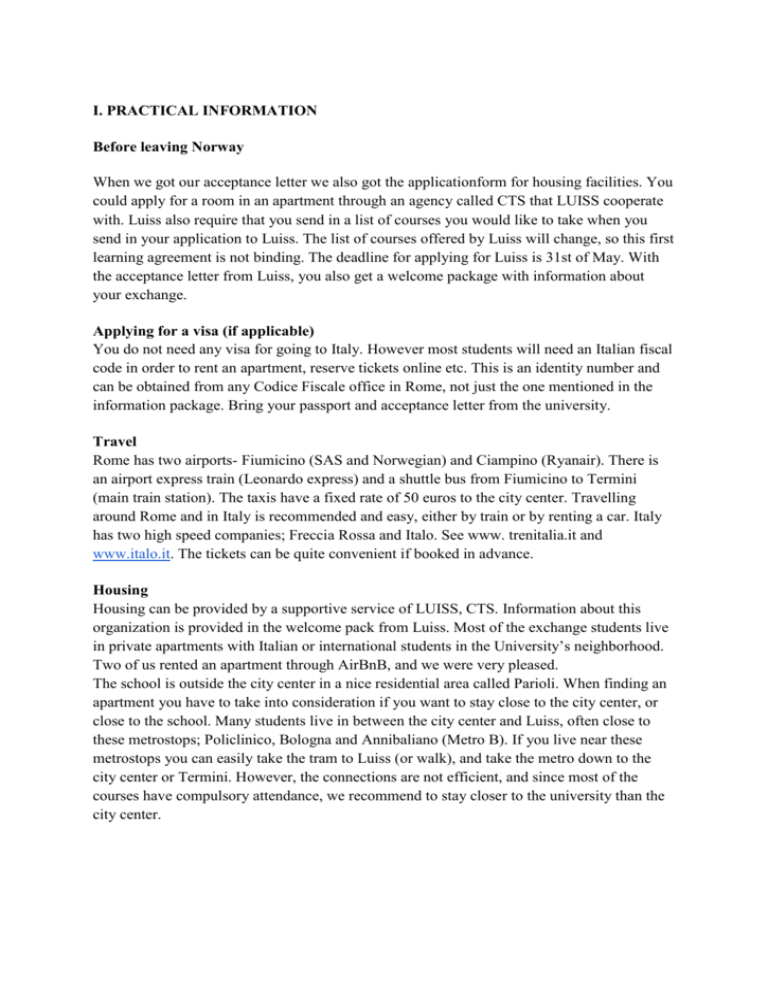
I. PRACTICAL INFORMATION Before leaving Norway When we got our acceptance letter we also got the applicationform for housing facilities. You could apply for a room in an apartment through an agency called CTS that LUISS cooperate with. Luiss also require that you send in a list of courses you would like to take when you send in your application to Luiss. The list of courses offered by Luiss will change, so this first learning agreement is not binding. The deadline for applying for Luiss is 31st of May. With the acceptance letter from Luiss, you also get a welcome package with information about your exchange. Applying for a visa (if applicable) You do not need any visa for going to Italy. However most students will need an Italian fiscal code in order to rent an apartment, reserve tickets online etc. This is an identity number and can be obtained from any Codice Fiscale office in Rome, not just the one mentioned in the information package. Bring your passport and acceptance letter from the university. Travel Rome has two airports- Fiumicino (SAS and Norwegian) and Ciampino (Ryanair). There is an airport express train (Leonardo express) and a shuttle bus from Fiumicino to Termini (main train station). The taxis have a fixed rate of 50 euros to the city center. Travelling around Rome and in Italy is recommended and easy, either by train or by renting a car. Italy has two high speed companies; Freccia Rossa and Italo. See www. trenitalia.it and www.italo.it. The tickets can be quite convenient if booked in advance. Housing Housing can be provided by a supportive service of LUISS, CTS. Information about this organization is provided in the welcome pack from Luiss. Most of the exchange students live in private apartments with Italian or international students in the University’s neighborhood. Two of us rented an apartment through AirBnB, and we were very pleased. The school is outside the city center in a nice residential area called Parioli. When finding an apartment you have to take into consideration if you want to stay close to the city center, or close to the school. Many students live in between the city center and Luiss, often close to these metrostops; Policlinico, Bologna and Annibaliano (Metro B). If you live near these metrostops you can easily take the tram to Luiss (or walk), and take the metro down to the city center or Termini. However, the connections are not efficient, and since most of the courses have compulsory attendance, we recommend to stay closer to the university than the city center. Costs The general cost of living in Italy is generally lower than in Norway, however the rent is higher in Rome than in other cities. I lived together with one friend in a nice apartment near Policlinico(Metro B) and the cost was 1500 euros a month. The cost of food in the supermarkets is a lot cheaper than in Norway and there are many nice inexpensive restaurants all over the city. In the University Canteen the price per meal is about 3 Euros and includes first course, main course, fruits and/or dessert and soft drinks. It is also possible to buy a reduced meal for only 2 euros. We did not buy a lot of books, most exams are based on slides and what the professor says in class. But if you want to buy a recommended textbook, you will have to ask the professor where to get it, as Luiss does not have its own bookstore at campus. It is also possible to print the books at a printing-store across the street of the campus. You can buy a monthly card for public transportation that costs 35 euros, at most ‘’Tabacchi’’ stores. The store are marked with a ‘’T’’ at the entrance. Italiens working at these stores does not get profit from selling these cards, so it is considered polite to buy an extra snack with the card. We bought an Italian sim-card from Wind, and pay 10 euros per month, that includes 300 sms, 300 minutes and 5GB internet. Culture and language Students at Luiss speaks good english, and most of the master courses at the university are taught in english. At the supermarket, citycenter etc. people tend to speak less English, and google translate will become a good friend. The italian culture is very different from the Norwegian culture. People are late for class, (even the professors), students talk loudly during lecture and cheating is common at the exams. There are a lot of groupworks in the courses at Luiss, and working with different cultures can be challenging. Students are late, they do not respect deadlines and tend to work very individualistically. However, italians are friendly and nice people. II. ABOUT THE SCHOOL LUISS Guido Carli is a relatively new private school founded in 1974. They have four departments: Economic and Finance, Business and Management, Law, and Political Science. With approximately 8000 students, it is small compared to other schools in Rome. Luiss have several campuses: Economics and Social Science Campus, Law Campus and LUISS University Headquarters, where the MBA programs take place. LUISS has a good network with the business environment. They have regular guest presentations and networking, but mainly in Italian. The campuses are located in a nice area of Rome close to Villa Ada. The study structure is pretty similar to that of BI. The amount of credits per course is mostly the same, also the duration of courses and number of lectures are similar. Besides some computer rooms, most of the rooms at the school are meant for lectures. Therefore it may be hard to find a dedicated study place. It is not uncommon to see other students studying in class rooms between lectures. The school has few study rooms where you can study without being interrupted, but these are mostly occupied all the time. LUISS is building a new study rooms, but not sure when they will be available for use. Course registration You register online for two weeks after the semester. The first two week you can try out many courses before you decide. You can also register for more courses than you need. Luiss also have a system called “web-self service”, that is an online registration system where you have to register for your exams in the middle of the semester. The examination system is very different than in Norway, so make sure that you have registered for all your needed examination dates. Academic calendar Arrival date: 10.09.15 First day of the semester: 14.09.15 Last day of classes: Examination period: 05.12.15 07.12.15 - 19.12.15 07.01.16 - 13.02.16 Arrival It´s easy to get from the airport “fiumicino” to the city center with public transportation. You can either take a direct shuttle bus that goes from outside of terminal 3 to termini, takes around 45 min depending on the traffic (the bus company I used is called T.A.M, but there are also other bus companies). You can also take a direct train from the airport to the central station, Termini, that takes around 30 min. Ticket for the bus cost around 5 € and the train ticket is around 14 €. Both tickets can be bought at the bus/train station. You can also take a taxi, but it is a bit more expensive. From the airport to termini its around 40-50 € and from the airport to piazza Bologna and piazza Annibaliano it´s around 50-60 €. The International Office The international office at Luiss is open Monday-Friday: 10am - 12 am, and Tuesday and Thursday 10am - 12 am/ 3 pm-5pm. People are nice and helpful, and quick to respond on Emails. Social activities There is a student organization called ESN LUISS that organize activities all through the semester. They are Italian students at the university, volunteering their time to organize fun parties, trips and dinners so that exchange students can get together. The first week of social activities is called “Welcome Week” where you get to meet all the other Erasmus students. There is a new activity every day: aperitivo, day trip, sightseeing around Rome, dinner and parties. ESN LUISS also organize different activities during the semester such as day trip to the wine festival in Marino, day trip to the Thermal baths in Calcata etc. They also arrange weekend trips to different cities in Italy, like Naples, Florence, Pisa and Siena. III. ACADEMICS In the classroom The way of teaching is similar to BI. The professors uses Power Points and interact with students during the class. Course materials Most of the exams are based on professor's lecture notes, and what has been thought in class. Even Though the course has a mandatory book, it was enough to study the slides. But if you want to buy a recommended textbook, you will have to ask the professor where to get it. The bookstore at campus was closed during the whole semester, and we bought some books at Amazone.it. If you find the books electronically, you can print them for free at the university or pay for printing at a printing-store across the street of the campus (the store has a database of books). Exams The exams at Luiss are different from what we are used to back home. Similar to most classes is that they all have a final written exam at the end of the semester. This exam is usually around 1-2 hours and often contains multiple choice questions. How much this exam counts depends on earlier completed class participation (often that you just attend the class), group presentations, hand-ins and mid-terms during the semester. The evaluation method varies from course to course, some are more oral that other. It is not possible to obtain exams from earlier semesters, but at the end of the course, each professor will go through a mock exam. This mock exam will give you some guidelines of the upcoming final exam. When you sign up for the exam you need to sign up for both the written and an oral exam (on Web Self Service). The oral exam is often on the same day or a few days after the final written exam. This exam usually never involves more than just signing the grade awarded to you. You can choose not to sign and approve you grade, but then you have to take a new exam in January or February. Students at Luiss most often have three attempts on their final exam. This means that you can retake the final exam in January and/or February if the exam dates in December overlaps or you just want to improve your grades. The grading system at Luiss runs from 1-30 points, where you pass at 18 points, and 30 points is the highest you can achieve. NOTE! If you are a MRR student travelling to Luiss, you have to obtain a final grade in each course at 26/30 points. This means that 26 points is approved as C at BI. (You need to get 86 % right on your exam to get this grade. Note that this is much higher requirement for a C than we are used to at BI, and it is difficult to get this grade since it´s considered as a quite good grade in Italy). Library and technology The main campus does not have a library, and there are few places to study. There are some group rooms/silent study rooms, but you must be there early to get a seat. Some of the lecture rooms are also used for studying. (We would recommend you to get a desk in your apartment). It is free to print at the university, but you have to print from the computer at the computerrooms and you can print maximum 50 pages at a time. The printing system can be a bit chaotic, so it's recommended to either print early (before 10.00 AM) or after 16.00 PM. Description of courses Planning and Control The purpose of the course is to discuss the logics and the methodologies related to planning and management control, as well as performance measurement and reporting. In particular, after having explored planning, measurement and control within the company's management system, the course focuses on themes such as cost analysis, budgeting, performance measurement and reporting. For more info: http://www.luiss.edu/cattedreonline/corso/SGE/0/19ILMBASE/2015 Our favorite course in many ways. The lecturer where extremely engaging making this course exiting. We had 2 lessons a week (1,5 hours each), with both lectures, company presentations and exercises. Our final grade was based on a written exam (100%). The exams consists of exercises and multiple choice questions. We would highly recommend this course! International Business The course on International Business is aimed to analyzing the management implications of globalization for business organizations. The course is concerned with understanding how the development of international trade interacts with the dynamics of companies competing at international or global levels. For more info: http://www.luiss.it/cattedreonline/corso/M171/0/19ILMBASE/2015 A management course, quite interesting, but not that engaging professor. 80% attendance required. We had 2 lessons a week (1,5 hours each), with both lectures, company presentations and cases. The final grade was based on a group project and hand in (50%) and a final written exam (50%). The written exam had 10 multiple choice questions and one open question. Performance measurement and financial reporting The program of the course is in two main parts. The first part focuses on financial statement analysis. The second part deals with performance measurement and evaluation. For more info: http://www.luiss.it/cattedreonline/corso/SHA/B/19MLMBASE/2015 Popular course among Italiens and exchange students. You can choose between canale A or B, it is the same course, but with different professors and schedule, so you have a chance to avoid overlaping courses. Taught 2 times a week (2 hours each) with both lectures and exercises. The final grade is based on 25% hand in and 75% final written exam. The final exam contains multiple choice-, theoretical- and true and false questions (50%) and exercises (50%). We would also like to recommend this course. Business Modeling and Planning This course aims at analysing the business model theory, value innovation, and planning and execution stages, in order to understand how firms develop their business idea, compete and create value. The professor expects you to be prepared and participate actively during class. The course runs tweeze a week, and it was case review and hearing once a week. There is no mandatory book in the course, but lectures are base on research papers. 50% of the grade is based on a term paper preformed by groups of five, and each group will be assigned a specific firm. After the hand in, the groups have to preform their paper in order to get the grade. The final written exam (50%) is based on articles and lecture notes, where the questions are quite specific related to information in the papers. The course is interesting and I learned a lot about companies’ business models and real life strategic choices. This course requires more work compared to others, as it requires class participation and group works. Fashion Management The main objectives of this course is to give the students the capacity to understand priorities so as to be able to manage the business with a “systemic” approach between Brand, Retail and Customer Experience Strategy. During the semester we had different small group works, and a major presentation, which counted for 40% of the grade. Class precipitation counted for 10% and the final exam counted for the last 50%. The lectures were based on a mandatory book (easy to read), in addition to the professors “real life experiences” during his long career in the fashion industry. The course was really interesting, and the theory is not just related to fashion, but to brands and customers in all sectors. Luxury Management The course aims at giving the students an understanding of the theory and practices typical of the luxury industry. The course is well structured, and go through 14 main areas of the luxury industry. The course structure is divided in two: lectures and group projects. We were divided in groups of 10 students, and had to prepare two projects during the semester. You are able to get additional points for the projects (0-3), even though the final exam counts for 100 % (30 points). The professor in the course has a lot of experience from the luxury industry, and the lectures are fun and inspiring. We also had a guest lecturer from industry. NOTE! If you are a MRR student you need to consider that LUISS doesn't have an ethics course (and as a MRR student you are obligated to take this as a part of your studies). We therefore decided to fly back home to Norway take ethics at BI in october. Otherwise you can also take the ethic course in the spring semester at BI, when you get back home from your exchange. Course code & name Master/ Bachelor Exam form Prerequisites Planning and Control (6 ects) Master 100% Written exam Basic understanding of financial accounting and financial statements. International Business (6 ects) Master 50% group presentation and hand in, 50% written exam None. Performance measurement and financial Master 25% hand in and Students are 75% written exam request to know the Approved as Comments 80% required attendance in class reporting (8 ects) Business Modeling and Planning (6 ects) basics of financial accounting. Master 50 % Term Paper and preentation 50% Written exam Basic strategy ( additional points for partisipaton in class (0-2)) Fashion Management (6 ects) Master 40% group project 10% class participation 50 % written exam None Luxury Management (6 ects) Master 100% written Exam None (antition points for group projects and participation (0-3)) On a final note, how will you sum up the exchange experience?
